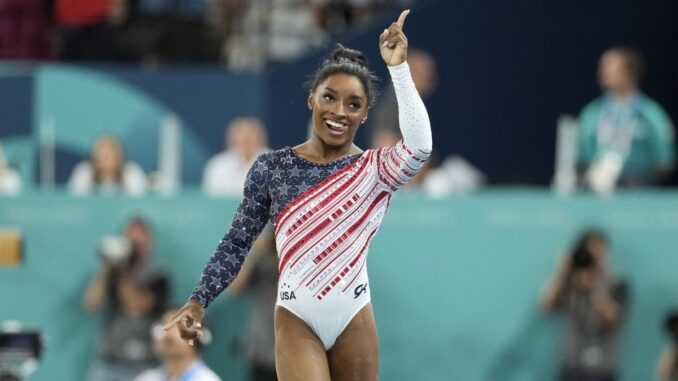
Simone Biles showed an example of courage as she announced her decision to retire from the Olympics to protect her body and mind. She told reporters she was experiencing some “twisties”. But what is this dangerous phenomenon described by gymnasts?
“Twisties” is an informal term that refers to a mental blockage that a gymnast may experience during movements in the air. When one experiences “twisties,” there is a disconnect between the brain and the body, Jamie Shapiro, a certified mental performance trainer, told Health. “The body knows what to do and motor programs are stored in the brain, but the brain has trouble accessing those motor programs,” she explained. Disconnecting the brain from the body can cause gymnasts to lose the ability to understand where they are in the air and to feel “a loss of control over movement.” This condition can cause physical problems – as gymnasts can only understand where they are when they hit the ground – and mental – as it is associated with anxiety and mental blockage.
The reasons for this phenomenon can be complex and research in this regard is still ongoing. Some of the possible causes may be anxiety, stress, fear of failure, desire not to disappoint others and the pressure of high expectations. In addition to these, it can also occur from focal dystonia, a neurological condition involving involuntary muscle spasms, which can result from overuse of muscle.
When Simone Biles withdrew from the Tokyo Olympics in 2021, the world gasped. Many wondered why the most decorated gymnast of all time would step back during her prime moment. The reason? A terrifying condition in gymnastics known as “the twisties.” This phenomenon is not just mental fatigue—it’s a dangerous disconnection between mind and body that can put gymnasts at serious risk of life-altering injuries.
In this article, we’ll break down what twisties are, why they happen, how they affect gymnasts like Biles, and why it’s so crucial to understand the mental and physical dangers behind them.
What Are the Twisties?
At its core, the twisties are a sudden loss of spatial awareness during aerial movements. Imagine flying through the air, twisting and flipping, but suddenly your brain loses track of where you are. That’s the twisties.
A Mental Block with Physical Consequences
Unlike stage fright or nerves, twisties create a dangerous disconnect. Gymnasts lose their sense of direction mid-air, which can lead to crashes, falls, and catastrophic injuries.
Comparable to ‘The Yips’ in Other Sports
Golfers talk about the “yips,” baseball players about throwing slumps, but in gymnastics, the consequences are much more dangerous. A golfer with the yips misses a putt; a gymnast with twisties could land on their head.
The Science Behind Twisties
Neurological Disruption
Twisties are essentially a neurological hiccup. The brain fails to sync with the body, disrupting the complex motor patterns gymnasts rely on.
Pressure and Stress Factors
High-pressure environments, extreme expectations, and stress may trigger the twisties. Mental health plays a huge role in how the body processes complex routines.
The Muscle Memory Breakdown
Gymnasts train movements thousands of times, but when twisties hit, muscle memory fails. The body does one thing while the brain signals another, creating dangerous misalignment.
Simone Biles and the Twisties
Why She Withdrew from the Olympics
During the 2021 Tokyo Games, Simone Biles experienced twisties on the biggest stage of her life. Knowing the risk of serious injury, she bravely chose to step away.
A Courageous Decision
Her withdrawal sparked debates, but in reality, it highlighted the importance of safety over medals. By prioritizing her well-being, Biles showed that athletes are not machines.
Breaking the Silence
Before Biles, twisties weren’t widely discussed outside gymnastics circles. Her openness brought global awareness to the issue, changing how fans and coaches view athlete mental health.
Why Twisties Are So Dangerous
Risk of Catastrophic Injury
Losing orientation mid-air can mean landing on the neck, spine, or head. One wrong landing could end a career—or worse.
The Unpredictable Nature
The twisties don’t arrive with a warning. A gymnast could be perfect in practice but suddenly lose control during competition.
Fear Amplifies the Problem
Once a gymnast experiences twisties, the fear of it happening again often makes the condition worse. It becomes a vicious cycle.
Signs of Twisties in Gymnasts
-
Sudden hesitation before routines
-
Mid-air confusion during flips or twists
-
Shaky landings and loss of form
-
Visible frustration and fear after attempts
How Do Gymnasts Overcome Twisties?
Stepping Back from Competition
Often, gymnasts need time away from high-pressure performances to reset mentally and physically.
Back-to-Basics Training
Coaches may take athletes back to simple drills—like practicing flips into foam pits—before progressing to advanced skills.
Therapeutic Support
Mental health professionals help gymnasts rebuild confidence, reestablish focus, and cope with stress.
The Role of Mental Health in Elite Sports
Beyond Physical Strength
Simone Biles reminded the world that mental resilience is just as important as physical conditioning. Without mental clarity, even the strongest bodies can falter.
Breaking the Stigma
For decades, mental health in sports was ignored or brushed aside. Biles’ honesty helped break down stigma, proving that mental challenges are real and deserve attention.
Twisties vs. Anxiety: Are They the Same?
While related, twisties and anxiety are different. Anxiety is the emotional stress athletes feel, while twisties are the physical manifestation—where the brain-body connection misfires.
Other Gymnasts Who Experienced Twisties
Simone Biles isn’t alone. Many gymnasts, both elite and recreational, report the same terrifying experience. However, it rarely makes headlines unless it happens to a global star.
Lessons from Simone Biles’ Story
-
Courage to Say No – She chose safety over pressure.
-
Awareness Matters – Her story educated millions about the risks of gymnastics.
-
Athletes Are Human – Even the best struggle with unseen battles.

The Public Reaction
Biles received both support and criticism. While some praised her bravery, others accused her of quitting. But the reality is simple: choosing life and safety over medals is never weakness—it’s wisdom.
Why Understanding Twisties Matters
For aspiring gymnasts, parents, and fans, knowing about twisties is essential. It fosters empathy, encourages safe training, and supports athletes when they need it most.
Prevention and Support
-
Encourage open conversations about mental health.
-
Provide safe practice environments with foam pits and harnesses.
-
Train coaches to recognize signs early.
-
Prioritize athlete well-being over medals.
Conclusion
The twisties are more than just a “mental block.” They are a serious, dangerous condition that puts gymnasts at risk every time they launch into the air. Simone Biles’ decision to step back wasn’t weakness—it was a powerful stand for safety and mental health in sports. Her bravery sparked a global conversation that will protect future generations of athletes.
